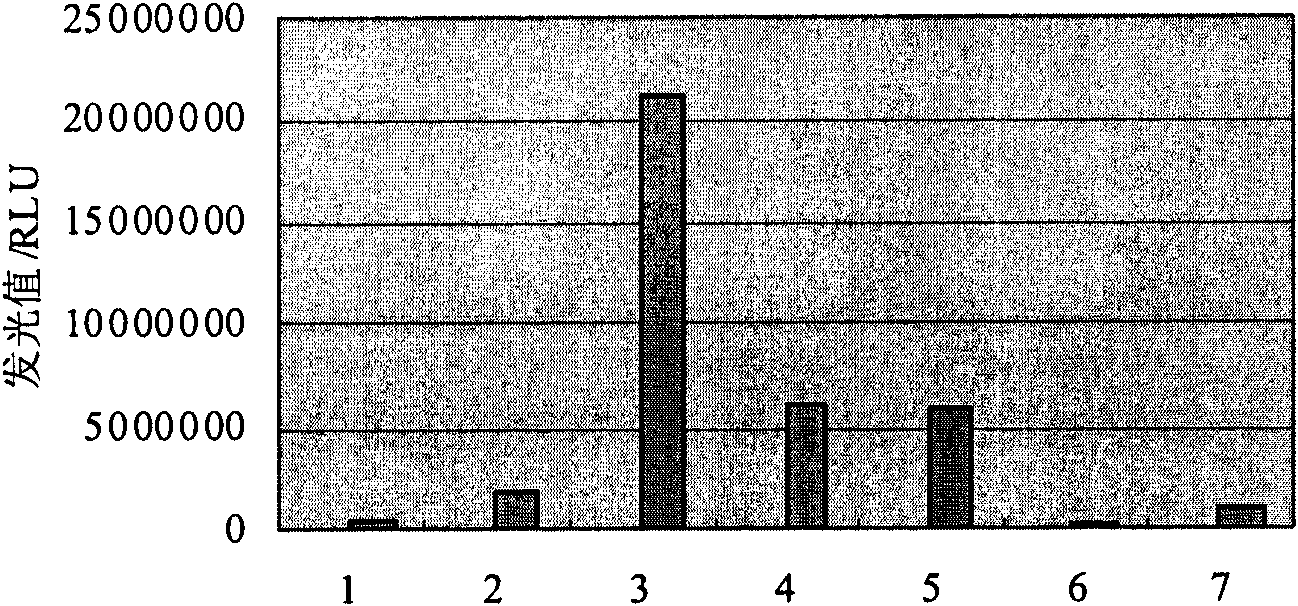Luminous bacteria and application thereof in detecting general biological toxicity in food or water sample
A technology of food and bacteria, applied in the field of luminescent bacteria and its application in the overall biological toxicity detection of food or water samples, can solve the problems of reducing the scope of application, doubting the authenticity and reliability of toxicity assessment, and achieving broad application Scope, realistic evaluation, effects of far-reaching application prospects
- Summary
- Abstract
- Description
- Claims
- Application Information
AI Technical Summary
Problems solved by technology
Method used
Image
Examples
Embodiment 1
[0093] Obtained Photobacterium CCTCC M 208027
[0094] Put 5.00g of deep-sea silt from the sea area of Ganyu in Haizhou Bay, place it in 100ml basal medium, incubate at 30℃, 200 rpm for 2 days, insert 1% of the inoculum into the same medium for passage 3 times. Then take 0.5ml of culture medium and dilute it gradually, take 10 -4 -10 -7 Each 0.1 ml of the diluted liquid was spread on a basal medium plate, cultured at 30°C for 2 days, and then observed in a dark room to pick out fluorescent colonies. They were respectively inoculated into basal salt culture test tubes, cultured in a shaker at 30° C. and 200 revolutions per minute for 24 hours, and their luminescence effects were detected with a chemiluminescence instrument.
[0095] The medium formula is:
[0096] Yeast extract 5.00g
[0097] Tryptone 5.00g
[0098] Sodium chloride NaCl 9.00g
[0099] Potassium chloride KCl 0.50g
[0100] Calcium chloride CaCl 2 ×2H 2 O 1.00g
[0101] Magnesium chloride MgCl 2 ×6H 2 O 3.00g
[01...
Embodiment 2
[0113] Preparation of Photobacterium CCTCC M 208027 Lyophilized Powder
[0114] The Photobacterium CCTCC M 208027 culture solution cultivated in Example 1 to the mid-log phase of growth was immediately placed on an ice water bath to perform the following operations:
[0115] Centrifuge for 5 minutes at 4℃, 15000g / min, discard the supernatant, resuspend once with 10ml of basic culture medium (slowly pipette evenly with a micropipette or dropper), and then centrifuge at 15000g / min at 4℃ After 5 minutes, discard the supernatant and use a freeze dryer to make it into a lyophilized powder of Photobacterium CCTCC M 208027.
[0116] The resulting solid powder is the finished product of Photobacterium CCTCC M 208027 freeze-dried powder.
Embodiment 3
[0118] Application of Photobacterium CCTCC M 208027 in the biological toxicity assessment of mixed toxicity simulation samples
[0119] The test simulation prepared contains a variety of toxic and harmful substances (the concentration of each toxic substance is IC 50 ) Mixed water samples H1, H2, H3, the types of toxic and hazardous substances contained in each sample are 2, 4, and 6 respectively (prepared according to Table 1, "+" represents the added type), and the water samples H1, H2, and H3 were diluted with concentration gradients (2 times, 4 times, 6 times, 8 times, 10 times), and then the Photobacterium CCTCC M 208027 obtained in Example 1 was used to detect the response to different samples and samples of different concentrations. Happening. A 50% inhibition of luminescence value is used as the toxicity criterion. See the result Figure 6 .
[0120] Table 1 Types of toxic and hazardous substances added to mixed water samples
[0121] Hg
As
Cr 6+
...
PUM
 Login to View More
Login to View More Abstract
Description
Claims
Application Information
 Login to View More
Login to View More - R&D
- Intellectual Property
- Life Sciences
- Materials
- Tech Scout
- Unparalleled Data Quality
- Higher Quality Content
- 60% Fewer Hallucinations
Browse by: Latest US Patents, China's latest patents, Technical Efficacy Thesaurus, Application Domain, Technology Topic, Popular Technical Reports.
© 2025 PatSnap. All rights reserved.Legal|Privacy policy|Modern Slavery Act Transparency Statement|Sitemap|About US| Contact US: help@patsnap.com



